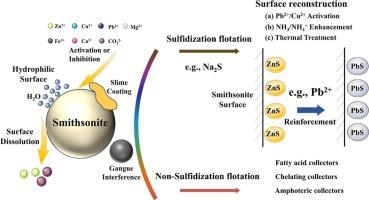Surface chemistry and flotation strategies of smithsonite: A review
IF 5
2区 工程技术
Q1 ENGINEERING, CHEMICAL
引用次数: 0
Abstract
The progressive depletion of high-grade zinc sulfide ores has shifted zinc production toward complex oxide resources, particularly smithsonite. However, the flotation of smithsonite remains highly challenging due to its intrinsic hydrophilicity, surface similarity to gangue minerals, and strong slime-forming tendency. These factors result in excessive reagent consumption, limited selectivity, and poor recovery of fine particles, ultimately restricting process efficiency and sustainability. Although considerable research efforts have been devoted to improving smithsonite flotation, the outcomes are often fragmented and lack systematic evaluation. This review provides a critical synthesis of recent advances in cleaner flotation strategies for smithsonite-rich ores. Key aspects include the interfacial chemistry and surface reactions governing flotation, a comparative assessment of sulfidization and non-sulfidization approaches, and the development of mixed and environmentally friendly collectors. Future research opportunities are also outlined, with particular emphasis on the molecular design of biodegradable selective reagents, the integration of machine learning for reagent system optimization, and the application of micro/nanobubbles to enhance fine particle recovery. Collectively, these developments chart a pathway toward more efficient, selective, and sustainable beneficiation of zinc oxide resources, thereby contributing to a resilient zinc supply for the global low-carbon transition.

辉钼矿的表面化学及浮选策略研究进展
高品位硫化锌矿石的逐渐枯竭已使锌生产转向复杂的氧化物资源,特别是菱锌矿。然而,由于其固有的亲水性,表面与脉石矿物相似,以及强烈的成泥倾向,菱锌矿的浮选仍然具有很高的挑战性。这些因素导致试剂消耗过多,选择性有限,细颗粒回收率差,最终限制了工艺效率和可持续性。虽然在改善菱锌矿浮选方面进行了大量的研究工作,但研究结果往往是零散的,缺乏系统的评价。本文综述了富菱锌矿的清洁浮选策略的最新进展。关键方面包括控制浮选的界面化学和表面反应,硫化和非硫化方法的比较评估,以及混合和环境友好型捕收剂的发展。展望了未来的研究机会,特别强调生物可降解选择性试剂的分子设计,试剂系统优化的机器学习集成,以及微/纳米气泡的应用,以提高细颗粒的回收率。总的来说,这些发展为提高氧化锌资源的效率、选择性和可持续性指明了道路,从而为全球低碳转型提供有弹性的锌供应。
本文章由计算机程序翻译,如有差异,请以英文原文为准。
求助全文
约1分钟内获得全文
求助全文
来源期刊

Minerals Engineering
工程技术-工程:化工
CiteScore
8.70
自引率
18.80%
发文量
519
审稿时长
81 days
期刊介绍:
The purpose of the journal is to provide for the rapid publication of topical papers featuring the latest developments in the allied fields of mineral processing and extractive metallurgy. Its wide ranging coverage of research and practical (operating) topics includes physical separation methods, such as comminution, flotation concentration and dewatering, chemical methods such as bio-, hydro-, and electro-metallurgy, analytical techniques, process control, simulation and instrumentation, and mineralogical aspects of processing. Environmental issues, particularly those pertaining to sustainable development, will also be strongly covered.
 求助内容:
求助内容: 应助结果提醒方式:
应助结果提醒方式:


